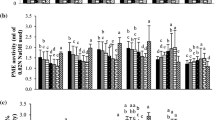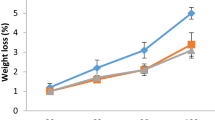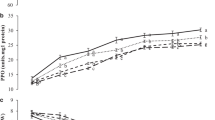Abstract
The effect of postharvest treatments on storage characteristics of harvested apricots in relation to fruit quality was investigated. ‘Xiaobai’ apricots treated with 1-methylcyclopropene (1-MCP), chlorine dioxide (ClO2), calcium, and heat in sealed container and then stored at 20 °C with 90 % relative humidity (RH) for 10 days. Results showed that the treatments could reduce respiration production and MDA content, delay softening, postharvest decay, the decrease of soluble solids (SSC), and visual changes. Furthermore, the polyphenol oxidase (PPO), polygalacturonase (PG), and pectin methylesterase (PME), superoxide dismutase (SOD), catalase (CAT), peroxidase (POD) activities were reduced by treatments. Taken together, it is suggested that ClO2 treatment might be an effective way to maintain the quality of apricot fruit except 1-MCP treatment.





Similar content being viewed by others
References
Aghdam MS, Bodbodak S (2013) Physiological and biochemical mechanisms regulating chilling tolerance in fruits and vegetables under postharvest salicylates and jasmonates treatments. Sci Hortic 156:73–85
Amoros A, Serrano M, Riquelme F, Romojaro F (1989) Levels of ACC and physical and chemical parameters in peach development. J Hortic Sci 64(6):171–175
De Martino G, Vizovitis K, Botondi R, Bellincontro A, Mencarelli F (2006) 1-MCP controls ripening induced by impact injury on apricots by affecting SOD and POX activities. Postharvest Biol Technol 39(1):38–47
Demartino G, Massantini R, Botondi R (2002) Temperature affects impact injury on apricot fruit. Postharvest Biol Technol 25:145–149
Fernández-Trujillo JP, Cano A, Artés F (2000) Interactions among cooling, fungicide and postharvest ripening temperature on peaches. Int J Refrig 23(6):457–465
Fu Y, Zhang K, Wang N, Du J (2007) Effects of aqueous chlorine dioxide treatment on polyphenol oxidases from Golden Delicious apple. LWT Food Sci Technol 40:1362–1368
Garc AJM, Herrera S, Morilla A (1996) Effects of postharvest dips in calcium chloride on strawberry. J Agric Food Chem 44:30–33
Giannopolitis CN, Ries SK (1977) Superoxide dismutases: I. Occurrence in higher plants. J Plant Physiol 59:309–314
Guo Q, Wu B, Xiao W-L,Wang, J-D (2010) Preparation and application of slow-released solid chlorine dioxide preservatives. Food Sci 31(18):441–444.
Guo Q, Lv X, Xu F et al (2013) Chlorine dioxide treatment decreases respiration and ethylene synthesis in fresh-cut ‘Hami’ melon fruit. Int J Food Sci Technol 48(9):1775–1782
Hadfield KA, Bennett AB (1998) Polygalacturonases: many genes in search of a function. J Plant Physiol 117(2):337–343
Hodges DM, Lester GE, Munro KD, Toivonen PMD (2004) Oxidative stress: importance for postharvest quality: oxidative stress: postharvest fruits and vegetables. J Am Soc Hortic Sci 39(5):924–929
Imahori Y, Takemura M, Bai J (2008) Chilling-induced oxidative stress and antioxidant responses in mume (Prunus mume) fruit during low temperature storage. Postharvest Biol Technol 49(1):54–60
Lee CY, Kagan V, Jaworski AW, Brown SK (1990) Enzymic browning in relation to phenolic compounds and polyphenoloxidase activity among various peach cultivars. J Agric Food Chem 38:99–101
Lee SY, Dancer GI, Chang SS, Rhee MS, Kang DH (2006) Efficacy of chlorine dioxide gas against alicyclobacillus acidoterrestris spores on apple surfaces. Int J Food Microbiol 108:364–368
Loaiza VJG, Mangrich ME, Campos VR, Saltveit ME (2003) Heat shock reduces browning of fresh-cut celery petioles. Postharvest Biol Technol 27:305–311
López-Serrano M, Ros Barceló A (1999) H2O2-mediated pigment decay in strawberry as a model system for studying color alterations in processed plant foods. J Agric Food Chem 47:824–827
Lurie S (1998) Postharvest heat treatments. Postharvest Biol Technol 14(3):257–269
Lurie S, Zhou H-W, Lers A, Sonego L, Alexandrov S, Shomer I (2003) Study of pectin esterase and changes in pectin methylation during normal and abnormal peach ripening. Physiol Plant 119(2):287–294
Mahmoud BSM, Bhagat AR, Linton RH (2007) Inactivation kinetics of inoculated Escherichia coli O157:H7, Listeria monocytogenes and salmonella enterica on strawberries by chlorine dioxide gas. J Food Microbiol 24(7–8):736–744
Picchioni GA, Watada AE, Conway WS, Whitaker BD, Sams CE (1998) Postharvest calcium infiltration delays membrane lipid catabolism in apple fruit. J Agric Food Chem 46:2452–2457
Scandalios JG (1993) Oxygen stress and superoxide dismutases. J Plant Physiol 101(1):7–12
Serrano M, Martínez-Romero D, Castillo S, Guillén F, Valero D (2005) The use of natural antifungal compounds improves the beneficial effect of MAP in sweet cherry storage. Innov Food Sci Emerg 6(1):115–123
Sevillano L, Sanchez-Ballesta MT, Romojaro F, Flores FB (2009) Physiological, hormonal and molecular mechanisms regulating chilling injury in horticultural species. Postharvest technologies applied to reduce its impact. J Sci Food Agric 89(4):555–573
Singleton VL, Rossi JA (1965) Colorimetry of total phenolics with phosphomolybdic-phosphotungstic acid reagents. Am J Enol Vitic 16:144–158
Sisler EC, Serek M (1997) IInhibitors of ethylene responses in plants at the receptor level: recent developments. Anglais 100:577–582
Sy KV, Murray MB, Harrison MD, Beuchat LR (2005) Evaluation of gaseous chlorine dioxide as a sanitizer for killing salmonella, escherichia coli O157:H7, Listeria monocytogenes, and yeasts and molds on fresh and fresh-cut produce. J Food Prot 68(6):1176–1187
Valverde JM, Guillen F, Martinez-Romero D, Castillo S, Serrano M, Valero D (2005) Improvement of table grapes quality and safety by the combination of modified atmosphere packaging (MAP) and eugenol, menthol, or thymol. J Agric Food Chem 53(19):7458–7464
Varoquaux P, Gouble B, Ducamp MN, Self G (2002) Procedure to optimize modified atmosphere packaging for fruit. Fruits 57(5–6):313–322
Wang YS, Tian SP, Xu Y (2005) Effects of high oxygen concentration on pro- and anti-oxidant enzymes in peach fruits during postharvest periods. Food Chem 91:99–104
Xiao LM, Zhong M, Wu B, Wang JD (2009) Effects of 1-methylcyclopropene and chlorine dioxide on preservation of Xinjiang oblate-peaches. Chin J Food Sci 12:276–280
Xie SZ, Wu B, Zhong M, Wang JD (2009) Effect of 1-methylcyclopropene on preservation of fresh-cut Hami melon. Chin J Food Sci 10:278–281
Xu WT, Peng XL, Luo YB, Wang JA, Guo X, Huang KL (2009) Physiological and biochemical responses of grapefruit seed extract dip on ‘Redglobe’ grape. LWT Food Sci Technol 42:471–476
Yan ZM, Lin J, Sheng BL, Li XG, Yang QS (2004) Effects of 1-MCP treatment on pear storage at room temperature. Chin J Agric Sci 20:189–193
Zhang Z, Pang X, Xuewu D, Ji Z, Jiang Y (2005) Role of peroxidase in anthocyanin degradation in litchi fruit pericarp. Food Chem 90:47–52
Zhong M, Wu B, Wang JD, Wu JM, Wei LH (2006) Effect of chlorine dioxide on ripening of ‘Xiaobai’ apricots. Eur Food Res Technol 223:791–795
Zhou HW, Ben AR, Lurie S (2000) Pectin esterase, polygalacturonase and gel formation in peach pectin fractions. Phytochemistry 55:191–195
Zhu S, Liu M, Zhou J (2006) Inhibition by nitric oxide of ethylene biosynthesis and lipoxygenase activity in peach fruit during storage. Postharvest Biol Technol 42(1):41–48
Zhu L-Q, Zhou J, Shu-Hua Z, Lai-Hui G (2009) Inhibition of browning on the surface of peach slices by short-term exposure to nitric oxide and ascorbic acid. Food Chem 114(1):174–179
Acknowledgments
Our research was supported by China Postdoctoral Science Foundation funded project (2012M521826) '12th Five-Year Plan' National Key Technology R & D program of China (No. 2011BAD27B01-01-02).
Author information
Authors and Affiliations
Corresponding author
Rights and permissions
About this article
Cite this article
Wu, B., Guo, Q., Wang, Gx. et al. Effects of different postharvest treatments on the physiology and quality of ‘Xiaobai’ apricots at room temperature. J Food Sci Technol 52, 2247–2255 (2015). https://doi.org/10.1007/s13197-014-1288-8
Revised:
Accepted:
Published:
Issue Date:
DOI: https://doi.org/10.1007/s13197-014-1288-8




